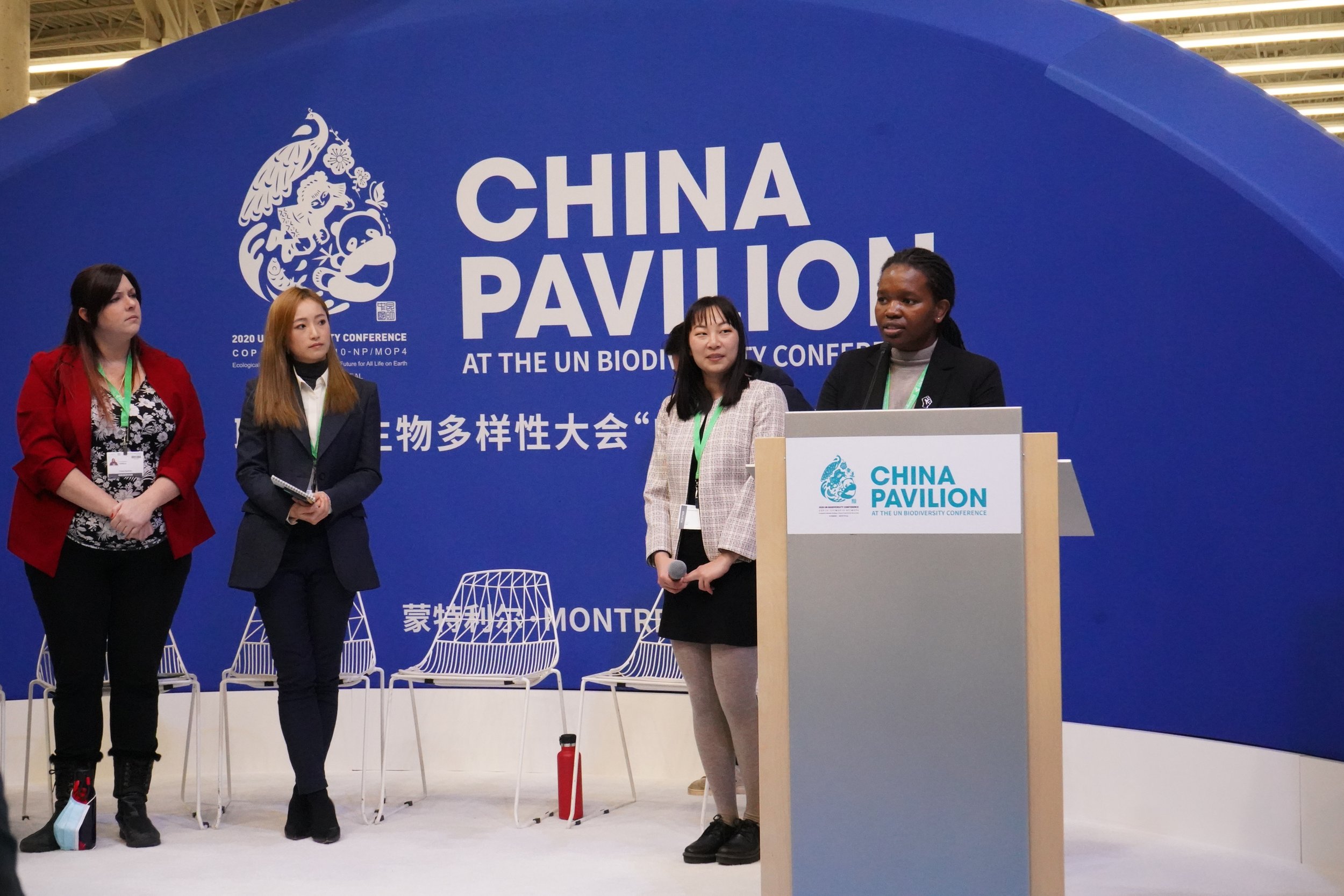COP15: UN Biodiversity Conference Makes History with Groundbreaking Agreement on Protecting Our Planet's Rich Diversity
The United Nations Convention on Biological Diversity's 15th Conference of the Parties (COP15) ended on December 19, 2022 in Montreal, Canada with the adoption of a groundbreaking biodiversity agreement. Following two weeks of intense negotiations, countries from around the globe reached a historic agreement on how to preserve and conserve global biodiversity. This momentous agreement, the first of its kind, establishes a framework for nations to work together to protect and restore the planet's biodiversity.
Aquatic Life Institute (ALI) had the opportunity to participate in this meeting, which took place from December 7 to December 19, 2022. Prisca Daka, the Engagement Coordinator for the Aquatic Animal Alliance, participated in several panel discussions, including one at the China Pavilion that focused on strengthening bilateral and multilateral agreements for a sustainable future. During these discussions, she emphasized the importance of integrating animal welfare into biodiversity conservation efforts and highlighted the work that the ALI is doing to promote the welfare of aquatic animals. She called on world leaders and other stakeholders to consider the well-being of all animals and the vital role that they play in maintaining healthy ecosystems. Healthy populations of aquatic species are critical to the health of our oceans, lakes, rivers, and other water sources.
Prisca Daka speaking on a panel with the UN Secretary General
Photo: UN
What Is In The Deal?
After four years of hard work, the Parties to the CBD adopted the Kunming-Montreal Global Biodiversity Framework (GBF) that includes 4 broad goals to be achieved through 23 specific targets which include securing the safe, legal and sustainable use and trade of wild species by 2030 as well as sustainably managing areas under agriculture, aquaculture, fisheries, and forestry among other things. The GBF is both promising and concerning. For starters, while the agreement sets out ambitious goals, it falls short in tackling the drivers of biodiversity loss, because it does not specifically call out the industries that cause the most ecological harm, such as commercial fishing and agriculture, or set concrete goals for them to place biodiversity conservation at the forefront of their practices. Second, the agreement is not legally binding, however nations must show that they are making progress toward fulfilling the objectives of the framework through national and global reviews. Nations must therefore avoid making the same mistakes they did with the Aichi Targets. The GBF replaces the UN Strategic Plan for Biodiversity 2011-2020 which included the Aichi Targets, which were set in Nagoya, Japan in 2010 and none of which, according to a 2020 CBD assessment, were fully met.
Outcomes Related to Aquatic Animals
This section will focus on some of the GBF targets that have a direct or indirect impact on both terrestrial and aquatic species, in order to provide a better understanding of how animal advocates can effectively protect the interests of animals and participate in the GBF's implementation.
Direct Exploitation of Species - Target 5, 9
Despite the fact that the framework encourages the sustainable use of wildlife and other natural resources, overexploitation has emerged as one of the top five direct human drivers of biodiversity loss worldwide. Fishing falls under this, particularly extremely harmful methods like bottom trawling, bycatch, and overfishing.
Managing Invasive Species - Target 6
Once established, it is very difficult to eliminate invasive species, and even when done so, it has a significant negative impact on the wellbeing of the introduced animals. When elimination is required, care should be taken to reduce the suffering of invasive species and negative consequences on native species.
Prevention of Pollution - Target 7
The health of our oceans depends upon the wellbeing of its inhabitants. We need healthy oceans to maintain a balanced ecosystem; if we let them get polluted or lose important species, this will eventually affect human populations as well.
Given that it has an impact on how they will ultimately be treated, it is crucial for animal advocates to understand how animals are treated in international agreements.
One Health Approach
The One Health Approach is an integrated approach to health care that recognizes the interconnectedness of animal, human, and environmental health. This approach recognizes that animal welfare and human health are deeply intertwined. One health is referenced in section C of the GBF:
‘The framework acknowledges the interlinkages between biodiversity and health and the three objectives of the Convention. The framework is to be implemented with consideration of the One Health Approach, among other holistic approaches that are based on science, mobilize multiple sectors, disciplines and communities to work together and aim to sustainably balance and optimize, the health of people, animals, plants and ecosystems, recognizing the need for equitable access to tools and technologies including medicines, vaccines and other health products related to biodiversity, while highlighting the urgent need to reduce pressures on biodiversity and decrease environmental degradation to reduce risks to health, and, as appropriate, develop practical access and benefit-sharing arrangements’.
Growing human activities like the handling of bushmeat, the trafficking of exotic animals, and the degradation of natural habitats are contributing to the threat of new infectious diseases spreading to people and other animals. Therefore, ignoring the connections between human health and how animals are treated could prevent us from finding solutions to serious public health issues.
Aquatic Animal Welfare and Biodiversity - What's the Connection?
The connection between aquatic animal welfare and biodiversity is complex and multifaceted. On one hand, the well-being of individual aquatic animals is an important consideration in its own right. Like all animals, aquatic animals have the capacity to experience suffering and should be protected from unnecessary harm. On the other hand, the health and welfare of aquatic animals is closely tied to the health and diversity of the ecosystems in which they live. In addition to the challenges posed by land-use change, environmental pollution, and water diversion, aquatic animals also experience the added stress of global climate change, one of the leading causes of biodiversity loss. Therefore protecting aquatic animals and their habitats is essential for maintaining the overall health and diversity of the world's [aquatic] ecosystems. However, animal welfare, let alone aquatic animal wellbeing, is not currently prioritized in biodiversity conservation.
Transformative Change
COP15 was a major milestone for global conservation efforts; it set ambitious targets in order to protect biodiversity around the world. While these goals are admirable, they can only be achieved if all nations take part in their implementation. All countries must recognize that protecting biodiversity is essential for all life on the planet, as well as environmental health. Without healthy ecosystems we cannot maintain our own wellbeing, the wellbeing of the other nonhuman beings we share the planet with or ensure future generations have access to clean air and water resources which are necessary for life on earth. Moreover, much advocacy is still needed to ensure that the interests of animals in general are represented at the UN Biodiversity Conference of the Parties or other international environmental agreements. Scientists have already warned that one million species are threatened with extinction, many within decades due to humans. Only through transformative change can we put nature on a path of recovery.
Our Conclusion
The lack of animal welfare in biodiversity conservation is a serious issue that needs to be addressed. Animal welfare plays an important role in preserving the health and diversity of species, which helps maintain the balance of our ecosystems. Unfortunately, many conservation efforts overlook this aspect, resulting in negative impacts on animals.
One lesson we can learn from this situation is that it’s essential to consider animal welfare when developing conservation strategies. This means taking into account not only physical needs such as food and shelter but also psychological ones like social interaction or stimulation with activities suited for their species type. Additionally, research should focus more on understanding how different types of animals interact with their environments so that appropriate measures can be taken to protect them while still allowing them access to natural resources they need for survival or reproduction purposes.
Finally, it’s important for us all – individuals as well as organizations –to play our part by advocating for better policies regarding animal welfare and speaking out against practices which harm wildlife populations or put undue stress on individual animals unnecessarily.
You can make a positive difference for aquatic animals by supporting our work.




